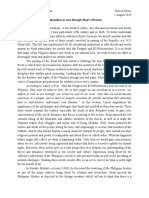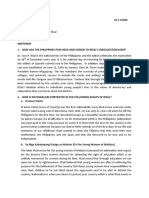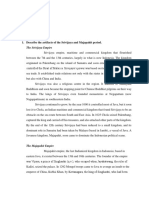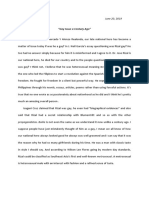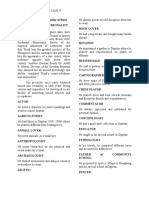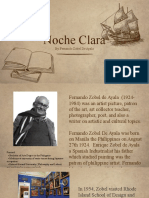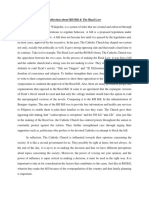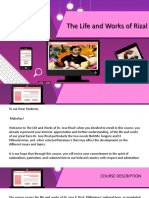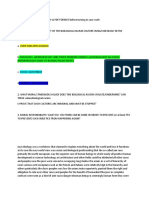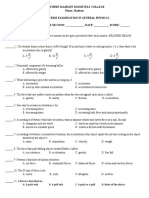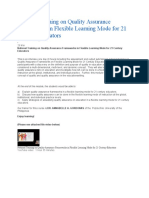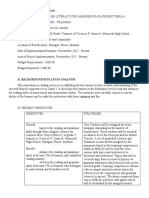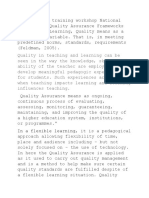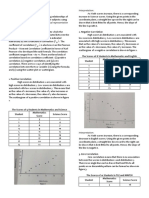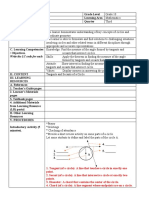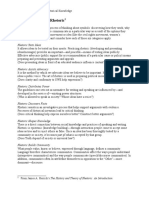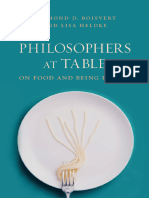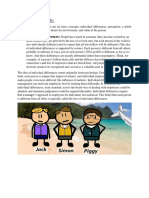Art Appreciation H1
Art Appreciation H1
Uploaded by
Ronieta VillanuevaCopyright:
Available Formats
Art Appreciation H1
Art Appreciation H1
Uploaded by
Ronieta VillanuevaOriginal Title
Copyright
Available Formats
Share this document
Did you find this document useful?
Is this content inappropriate?
Copyright:
Available Formats
Art Appreciation H1
Art Appreciation H1
Uploaded by
Ronieta VillanuevaCopyright:
Available Formats
Handout #1 - Introductions and Definitions human condition.
As an expressive medium it allows us to
experience sublime joy, deep sorrow, confusion and clarity. It
OVERVIEW tests our strengths, vulnerabilities and resolve. It gives voice
This handout gives a basic understanding of how art is to ideas and feelings, connects us to the past, reflects the
defined and the different ways it functions in societies and present and anticipates the future. Along these lines, art
cultures. It covers the following topics: history, combined with anthropology and literature, are three
main sources in observing, recording and interpreting our
What is Art? human past. Visual art is a rich and complex subject whose
Form and Content definition is in flux as the culture around it changes. Because
Aesthetics of this, how we define art is in essence a question of
Subjective and Objective Perspectives agreement. In this respect, we can look again to the
Artistic Roles dictionary’s definition for an understanding of exactly what
Artistic Categories to look for when we proclaim something as ‘art’.
Artistic Styles
Ideas of Perception and Visual Awareness FORM & CONTENT
Two basic considerations we need to be acquainted with
OBJECTIVES are form: the physical and visible characteristics inherent in
works of art, and content: the meaning we derive from them.
Upon successful completion of this handout, you should be
Formal distinctions include a work’s size, medium (painting,
able to:
drawing, sculpture or other kind of work) and descriptions of
compositional elements such as the lines, shapes and colors
Define ‘art’ within a cultural perspective. involved. Issues of content include any visual clues that
Explain the difference between ‘objective’ and provide an understanding of what the art tells us. Sometimes
‘subjective.’ an artwork’s content is vague or hidden and needs more
Explain the different roles art plays within different information than is present in the work itself. Ultimately
cultures. these two terms are roped together in the climb to
Define the term ‘subject matter.’ understand what art has to offer us. As we examine art from
Define the categories ‘realistic’, ‘abstract,’ and ‘non- different time periods, styles and cultures, the issues of form
objective.’ and content will apply to all of them. We’ll explore form and
Recognize, evaluate, and describe artistic styles. content further in Handouts 3 and 4.
Discuss the meaning of ‘aesthetics’ and its
relationship to cultural conventions. AESTHETICS
Identify and discuss issues of visual awareness.
Aesthetics is the philosophical argument about the nature of
beauty. It’s an idea central to any exploration of art.
WHAT IS ART? Aesthetics deals with notions of taste, cultural conventions –
ideas of art being ‘good’ and ‘bad’ based on specific cultural
information and beliefs and the judgments we make based
on our perceptions.
As deep as visual art is embedded in the fabric of our lives, it
still is the source of controversy and irony. It thrives on
common experience yet contradicts ideas of ourselves. Art is
part of the culture it’s created in, but can reflect many
cultures at once. From where you and I stand today art has
become probably more complex than ever in its use of
Panorama of a section of A Thousand Li of Mountains and Rivers, by Wang imagery, mediums and meanings. We need a way to access
Ximeng from the 12th-century Song Dynasty the visual information of our society, of past cultures, and
cultures not known to us to have a way to understand what
How would you define ‘art’? For many people art is a specific we are looking at.
thing; a painting, sculpture or photograph, a dance, a poem
or a play. It is all of these things, and more. They are SUBJECTIVE & OBJECTIVE PERSPECTIVES
mediums of artistic expression. Webster’s New Collegiate
The first level in approaching art is learning to LOOK at it. In
dictionary defines art as “The conscious use of skill and
future discussions we will spend more time in pure
creative imagination especially in the production of aesthetic
observation than you probably have done before. Generally,
objects.” Yet art is much more than a medium, or words on a we tend to look at art in terms of "liking" it FIRST, and
page. It is the expression of our experience. Joseph Brodsky "looking" at it later. From this perspective,
hints at a definition of art in his poem “New Life”: the subjective (knowledge residing in the emotions and
thoughts of the viewer) almost completely dominates our
“Ultimately, one’s unbound
way of looking at art. In the arts, it’s especially important to
curiosity about these empty zones, begin to develop an informed or objective opinion rather
than just an instinctual reaction. An objective view is one that
about these objectless vistas, focuses on the object’s physical characteristics as the main
source of information. This does not mean that you will
is what art seems to be all about.” remove or invalidate your subjective feelings about a work, in
fact you will find that the more informed you become,
Art is uniquely human and tied directly to culture. It takes the
the more artwork will affect you emotionally and
ordinary and makes it extraordinary. It asks questions about
intellectually. It does mean that you will learn alternative
who we are, what we value, the meaning of beauty and the ways to approach art, ways that allow you to find clues to
1
meaning and to understand how art reflects and affects our physical information such as geological elements and the
lives. plants and animals within a particular region.
It’s complex, but the satisfaction of looking at art comes In many western cultures, the more realistic the rendering of
from exploring the work to find meaning, not shying away a scene the closer to our idea of the ‘truth’ it becomes. In the
from it simply because we may not understand it. 15th century German artist Albrecht Durer creates vivid works
that show a keen sense of observation. His Young Hare from
ARTISTIC ROLES 1495 is uncanny in its realism and sense of animation.
Visual artists and the works they produce perform specific
roles. These roles vary between cultures. We can examine
some general areas to see the diversity they offer – and
perhaps come up with some new ones of our own.
Description
A traditional role of visual art is to describe our self and our
surroundings. Some of the earliest artworks are drawings and
paintings of humans and wild animals on walls deep within
prehistoric caves. One particular image is a print: a universal
symbol of human communication.
Albrecht Durer, Young Hare, c. 1505, gouache and watercolor on
Portraits paper. Albertina Museum, Vienna.
Image in the public domain.
Portraits, landscapes and still life are common examples of
description. Portraits capture the accuracy of physical Scientific Illustration
characteristics but the very best also transfer a sense of an Out of this striving for accuracy and documentation
individual’s unique personality. For thousands of years this developed the art of scientific illustration. The traditional
role was reserved for images of those in positions of power, mediums of painting and drawing are still used to record
influence and authority. The portrait not only signifies who much of the world around us. Linda Berkley’s Merino
they are, but also solidifies class structure by presenting only Ram uses a layered approach to record in great detail the
the highest-ranking members of a society. The portrait bust physical anatomy of the head of the great sheep.
of Egyptian Queen Nefertiti, dated to around 1300 BCE,
exemplifies beauty and royalty.
Merino Ram, composite drawing, colored pencil, acrylic on Canson paper,
2009. Linda Berkley, Illustrator.
Egyptian, Bust of Nefertiti, painted sandstone, c. 1370 BCE, Neues Museum, Used by permission of the artist
Berlin.
Licensed under Creative Commons and GNU. Enhancing our World
The full-length Imperial Portrait of Chinese Emperor Enhancing the world of our everyday lives is another role art
Xianfeng below not only shows realism in the likeness of the plays. This role is more utilitarian than others. It includes
emperor, it exalts in the patterns and colors of his robe and textiles and product design, decorative embellishments to
the throne behind him. the items we use everyday and all the aesthetic
considerations that create a more comfortable, expressive
environment
Narratives: How Artists Tell Their Stories
Artists can combine representation with more complex
elements and situational compositions to bring a narrative
component into art. Using subject matter – the objects and
figures that inhabit a work of art -- as a vehicle for
communicating stories and other cultural expressions is
another traditional function of visual art.
Imperial Portrait of Emperor Xianfeng, China, c. 1855. Palace Museum, Bejing.
Licensed under Creative Commons. The narrative tradition is strong in many cultures throughout
the world. They become a means to perpetuate knowledge,
Landscapes morals and ethics, and can signify historical contexts within
specific cultures. Narrative takes many forms; the spoken or
Landscapes – by themselves – give us detailed information written word, music, dance and visual art are the mediums
about our natural and human made surroundings; things like most often used. Many times one is used in conjunction with
location, architecture, time of day, year or season plus other another. In his Migration Series, Jacob Lawrence paints stark,
direct images that communicate the realities of the African
2
American experience in their struggle to escape the
repression of the South and overcome the difficulties of
adjusting to the big cities in the North.
In contrast, photographers used the camera lens to
document examples of segregation in the United States.
Here the image on film tells its poignant story about
inequalities
based on race.
Stucco Ganhara figure, India, 4th–5th century CE. Victoria & Albert Museum,
London.
Licensed through GNU
Popular Culture
This category contains the many products and images we are
Man Drinking at a Water Cooler in the Street Car Terminal, Russell Lee, exposed to every day. In the industrialized world, this
Oklahoma City, 1939. includes posters, graffiti, advertising, popular music,
Photo from the National Archives and in the public domain
television and digital imagery, magazines, books and movies
Spirit, Myth and Fantasy (as distinguished from film, which we’ll examine in a different
context later in the course). Also included are cars, celebrity
Tied to the idea of narrative, another artistic role is the status and all the ideas and attitudes that help define the
exploration of other worlds beyond our physical one. This contemporary period of a particular culture.
world is in many ways richer than our own and includes the
world of spirit, myth, fantasy and the imagination; areas Handbills posted on telephone poles or the sides of buildings
particularly suited for the visual artist. We can see how art are graphic, colorful and informative, but they also provide a
gives a rich and varied treatment to these ideas. Artist street level texture to the urban environment most of us live
Michael Spafford has spent his career presenting classical in. Public murals serve this same function. They put an
Greek myths through painting, drawing and printmaking. His aesthetic stamp on an otherwise bland and industrialized
spare, abstract style uses high contrast images to strong landscape.
dramatic effect. A Smiling Figure from ancient Mexico
portrays a god of dance, music and joy. A third example,
Hieronymus Bosch’s painting the Temptation of Saint
Anthony , gives the subject matter both spiritual and bizarre
significance in the way they are presented. His creative
imagination takes the subject of temptation and raises it to
the realm of the fantastic. There is an entire module devoted
to the idea of the other world later in this course.
ARTISTIC CATEGORIES
Visual arts are generally divided into categories that make Street handbills. Image by Christopher Gildow
distinctions based on the context of the work. For example, Licensed through Creative Commons
Leonardo da Vinci’s ‘Mona Lisa’ would not fall into the same
category as, say, a graphic poster for a rock concert. Some
artworks can be placed in more than one category. Here are
the main categories:
Fine Art
This category includes drawings, paintings, sculptures,
photographs and, in the last decade, new media that are in
museum collections and sold through commercial art
galleries. Fine art has a distinction of being some of the finest Public Mural, Seattle. Image by Christopher Gildow
examples of our human artistic heritage. Here is where you Licensed through Creative Commons
will find Leonardo Da Vinci’s Mona Lisa (below), also ancient
sculpture, such as the Gandhara figure from India (also Craft
below), and stunning ceramics from different cultures and
time periods. Craft is a category of art that shows a high degree of skilled
workmanship in its production. Craft works are normally
associated with utilitarian purposes, but can be aesthetic
works in themselves, often highly decorated. The Mexican
ceramic vessel below is an example. Handmade furniture and
glassware, fine metalworking and leather goods are other
examples of craft.
Mona Lisa, Leonardo Da Vincic. 1503-19. Oil on poplar. 30” x 21”. The Louvre,
Paris
Image licensed through Creative Commons
3
background. In all three of these, the artists manipulate and
distort the ‘real’ landscape as a vehicle for emotion.
It’s important to note the definition of ‘abstract’ is relative to
cultural perspective. That is, different cultures develop
traditional forms and styles of art they understand within the
context of their own culture (see ‘Cultural Styles’ below), and
which are difficult for other cultures to understand. So what
Ceramic bowl, Mexico. Date unknown. Painted clay. Anahuacalli Museum, may be ‘abstract’ to one could be more ‘realistic’ in style to
Mexico City. another. For example, the Roman bust of Sappho below
Licensed through GNU and Creative Commons. looks very real from a western European aesthetic
perspective. Under the same perspective, the African mask
ARTISTIC STYLES
would be called ‘abstract’.
Style
The search for truth is not exclusive to representational art.
From viewing many of the examples so far you can see how
individual artists use different styles to communicate their
ideas. Style refers to a particular kind of appearance in works
of art. It’s a characteristic of an individual artist or a collective
relationship based on an idea, culture or artistic movement.
Following is a list and description of the most common styles
in art: Roman bust of Sappho. Capitoline Museum, Rome.
Image in the public domain.
Naturalistic Style
Naturalistic style uses recognizable images with a high level
of accuracy in their depiction. Naturalism also includes the
idealized object: one that is modified to achieve a kind of
perfection within the bounds of aesthetics and form. William
Sydney Mount’s painting The Bone Player (Links to an
external site.) gives accuracy in its representation and a sense
of character to the figure, from his ragged-edged hat to the
button missing from his vest. Mount treats the musician’s
portrait with a sensitive hand, more idealized by his African mask photo by Cezary.
handsome features and soft smile. Note: click the image for a Image in the public domain.
larger view.
Yet to the African culture that produced the mask it would
Abstract Style appear more realistic. In addition, the African mask shares
some formal attributes with the Tlingit ‘Groundhog
Abstract style is based on a recognizable object but which is Mask’ (below under ‘Cultural styles’) from Canada’s west
then manipulated by distortion, scale issues or other artistic coast. It’s very possible these two cultures would see the
devices. Abstraction can be created by exaggerating form, Roman bust as the ‘abstract’ one. So it’s important that we
simplifying shapes or the use of strong colors. Let’s look at understand artworks from cultures other than our own in the
three landscapes below with varying degrees of abstraction context in which they were originally created.
in them to see how this style can be so effective. In the first
one, Marsden Hartley uses abstraction to give the Questions of abstraction can also emerge from something as
spare “Landscape, New Mexico” a sense of energy. Through simple as our distance from an artwork. View and read
the rounded forms and gesture in treatment we can discern about Fanny/Fingerpainting by the artist Chuck Close. At first
hills, clouds, a road and some trees or bushes. glance it is a highly realistic portrait of the artist’s
grandmother-in law. You can zoom it in to see how the
painting dissolves into a grid of individual fingerprints, a
process that renders the surface very abstract. With this in
mind, we can see how any work of art is essentially made of
smaller abstract parts that, when seen together, make up a
coherent whole.
Non-objective imagery has no relation to the ‘real’ world –
that is – the work of art is based solely upon itself. In this way
the non-objective style is completely different than abstract,
and it’s important to make the distinction between the two.
Landscape, New Mexico, Marsden Hartley, about 1916. Pastel on paper. The
Brooklyn Museum, New York.
This style rose from the modern art movement in Europe,
Image in the public domain Russia and the United States during the first half of the
20th century. Pergusa Three by American artist Frank Stella
Georgia O’Keeffe’s Birch and Pine Trees -- Pink employs uses organic and geometric shapes and strong color set
abstraction to turn the painting into a tree-filled landscape against a heavy black background to create a vivid image.
dominated by a spray of orange paint suggesting a branch of More than with other styles, issues of content are associated
birch leaves at the top left. Vasily Kandinsky’s Landscape with with a non-objective work’s formal structure.
Red Spots, No. 2 goes further into abstraction, releasing color
from its descriptive function and vastly simplifying forms. The Cultural Styles
rendering of a town at the lower left is reduced to blocky
Cultural styles refer to distinctive characteristics in artworks
areas of paint and a black triangular shape of hill in the
throughout a particular society or culture. Some main
4
elements of cultural styles are recurring motifs, created in example, let’s look at two images that share one particular
the same way by many artists. Cultural styles are formed element; that of raised arms, and see how we perceive each
over hundreds or even thousands of years and help define one according to what we know about them.
cultural identity. We can find evidence of this by comparing
two masks; one from Alaska and the other from Canada.
The Yup'ik dance mask from Alaska is quite stylized with
oval and rounded forms divided by wide bands in strong
relief. The painted areas outline or follow shapes. Carved
objects are attached to the mask and give an upward
movement to the whole artwork while the face itself carries
an animated expression.
By comparison, a ‘Groundhog Mask’ from the Tlingit culture in
coastal northwestern Canada exhibits similar forms and many
of the same motifs. The mouths of each mask are particularly
similar to each other. Groundhog’s visage takes on human –
like characteristics just as the Yup’ik mask takes the form of a
bird. This cultural style ranges from western Alaska to Standing Bather with Raised Arms, 1930, Aristide Maillol, Marble
northern Canada. Photo by Flickr User: zebrawatcher
License through Creative Commons
Ground Hog Mask,Tlingit, c. 19th century. Carved and painted wood, animal
hair.
Touchdown Jesus , Monroe, Ohio
Collection the Burke Museum, University of Washington, Seattle. Used by
Photo by Flickr User: danieljohnsonjr
permission.
License through Creative Commons
Celtic art from Great Britain and Ireland shows a cultural style
that’s been identified for thousands of years. Its highly Art is a resource for questioning our perceptions about how
refined organic motifs include spirals, plant forms objects and ideas present themselves. The Belgian artist Rene
and zoomorphism . Intricate and decorative, the Celtic style Magritte used his easel as a soapbox to confront the viewer
adapted to include early book illustration. The Book of Kells is with confounding visual information.
considered the pinnacle of this cultural style.
As was mentioned at the beginning of this handout, there is a
difference between looking and seeing. To look is to glance
back and forth, aware of surface qualities in the things that
come into our line of sight. To see is more about
comprehending. After all, when we say “I see” we really
mean that we understand. Seeing goes beyond appearances.
So, as we confront the huge amounts of visual information
coming at us we start to make choices about what we keep
and what we edit out. We concentrate on that which has the
most meaning for us: a street sign that helps us get home, a
Page from the Book of Kells, around 800 CE. Trinity College, Dublin. view of the mountains that lets us enjoy a part of nature’s
Image in the public domain. spectacle, or the computer screen that allows us to gather
information, whether it’s reading the content in this course
IDEAS OF PERCEPTION & VISUAL AWARENESS
or catching up on the day’s news or emails. Our gaze
Images from media and the environment around us – becomes more specific, and with that comes specific
dominate our perception. Our eyes literally navigate us meaning. At this point what we see becomes part of what we
through a visual landscape all our lives, and we all make know. It’s when we stop to contemplate what we see – the
decisions based on how and what we see. Separating the view of the mountain mentioned above, a portrait or simple
subjective and objective ways we see helps us become more visual composition that catches our eye – that we make
visually aware of our surroundings. Scientifically, the process reference to an aesthetic perception. That is, when something
of seeing is the result of light passing through the lens in our is considered for its visual properties alone, and their relation
eye, then concentrating it on the retina at the back of the to our ideas of what is beautiful, as a vehicle for meaning.
eye. The retina has nerve cells that act like sponges, soaking
No matter how visually aware we are, visual clues alone
up the information and sending it to the visual cortex of our
hinder our ability to fully comprehend what we see. Words,
brain. Here the light is converted to an image that we can
either spoken or read as text, help fill in the blanks to
perceive – the ‘truth’ – as we understand it to be. We are
understanding. They provide a context; a historical
exposed to so much visual information every day, especially
background, religious function or other cultural significance
with the advent of mass media, that it’s hard to process all of
to the art we are looking at. We ask others for information
it into specific meaning. Being visually aware is more
about it, or find it ourselves, to help understand the meaning.
complicated than just the physical act of seeing because our
In a museum or gallery it may be wall text that provides this
perceptions are influenced by exterior factors, including our
link, or a source text, website or someone knowledgeable
own prejudices, desires and ideas about what the ‘truth’
about the art.
really is. Moreover, cultural ties to perception are many. For
5
Now that we have a basic understanding of what art is, the
cultural roles it plays and the different categories and styles it
can belong to we can begin to explore more specific physical
and conceptual issues surrounding it.
You might also like
- Ideas and Idealism in PhilosophyDocument300 pagesIdeas and Idealism in PhilosophyjemenNo ratings yet
- Come On, Rain! S1Document24 pagesCome On, Rain! S1S TANCRED100% (1)
- Critique de LeonDocument2 pagesCritique de LeonBernadette TaripeNo ratings yet
- Module 1: Republic Act 1425 "Rizal Law": ObjectivesDocument6 pagesModule 1: Republic Act 1425 "Rizal Law": ObjectivesJanelle PedreroNo ratings yet
- M1-1 Humanities Past, Present and Future. POST-TASK (Combo)Document2 pagesM1-1 Humanities Past, Present and Future. POST-TASK (Combo)Nathaniel ComboNo ratings yet
- Archaeological Theory Today (Ian Hodder Ed)Document164 pagesArchaeological Theory Today (Ian Hodder Ed)Samara Dyva100% (13)
- History of Ancient Philosophy IDocument22 pagesHistory of Ancient Philosophy IThomisticPhilosophy33% (3)
- AMENDMENTs TO RA 5527Document33 pagesAMENDMENTs TO RA 5527Ashley Nicole DelizoNo ratings yet
- Critical Essay Maningas PDFDocument3 pagesCritical Essay Maningas PDFKimNo ratings yet
- Importance of RA 1425Document5 pagesImportance of RA 1425Deborah TorresNo ratings yet
- LESSON-1-3 Rizal LifeDocument13 pagesLESSON-1-3 Rizal Lifekyle swayNo ratings yet
- Historical Background and Context of RA 1425Document2 pagesHistorical Background and Context of RA 1425VELUNTA, Nina Gabrielle100% (2)
- Senate Bill No. 438: The Birth of RizalDocument3 pagesSenate Bill No. 438: The Birth of RizalKaye PurificacionNo ratings yet
- History of The Philippine IslandsDocument2 pagesHistory of The Philippine IslandsskzrachaNo ratings yet
- RizalDocument2 pagesRizalYen CornelioNo ratings yet
- The Travels of RizalDocument6 pagesThe Travels of RizalChristine BelleNo ratings yet
- Pen 2a MidtermDocument28 pagesPen 2a MidtermJann ericka JaoNo ratings yet
- Chinese History in The PhilippinesDocument2 pagesChinese History in The PhilippineslauriceNo ratings yet
- A La Juventud FilipinaDocument1 pageA La Juventud FilipinaSamuel ArgoteNo ratings yet
- Our Task - To Make Rizal Obsolete Part 2 of 2Document9 pagesOur Task - To Make Rizal Obsolete Part 2 of 2Bert M DronaNo ratings yet
- LIWORIZ Reviewer For Long Test 1 PDFDocument14 pagesLIWORIZ Reviewer For Long Test 1 PDFJhamille SalongaNo ratings yet
- Chapter 1 - RizalDocument13 pagesChapter 1 - RizalheyzzupNo ratings yet
- 1.3 Art Functions-Philo PerspectivesDocument27 pages1.3 Art Functions-Philo PerspectivesmaricrisandemNo ratings yet
- Written Report RizalDocument12 pagesWritten Report RizalChristian Mark BanalNo ratings yet
- Ra 5527Document26 pagesRa 5527chocoholic potchi100% (4)
- Chapter 2Document6 pagesChapter 2MR éxypnosNo ratings yet
- Comprehensive Reading 2 Reflection PaperDocument2 pagesComprehensive Reading 2 Reflection PaperMelvin Garcia SalopagioNo ratings yet
- Life and Works of Rizal Week 1Document7 pagesLife and Works of Rizal Week 1ten tenNo ratings yet
- Source: Sonia S. Daquila. The Seeds of RevolutionDocument6 pagesSource: Sonia S. Daquila. The Seeds of RevolutionJulliena BakersNo ratings yet
- Lesson Proper For Week 1: Art HistoryDocument19 pagesLesson Proper For Week 1: Art HistoryFrahncine CatanghalNo ratings yet
- Philosophies in Life of RizalDocument4 pagesPhilosophies in Life of RizalErikaAlidioNo ratings yet
- Alice Guillermo Philippine Contemporary Aesthetics 1Document9 pagesAlice Guillermo Philippine Contemporary Aesthetics 1Casey Margaret SolisNo ratings yet
- Essay - Who Is Jose RizalDocument1 pageEssay - Who Is Jose Rizalarnel tarucNo ratings yet
- RIZALDocument3 pagesRIZALDiane LorenzoNo ratings yet
- Bring Your Future Into GOODNESS!: 2x2 PhotoDocument2 pagesBring Your Future Into GOODNESS!: 2x2 Photonathan casinaoNo ratings yet
- Writing Report Science and Technology in Nation BuildingDocument11 pagesWriting Report Science and Technology in Nation BuildingissanNo ratings yet
- Describe The Artifacts of The Srivijaya and Majapahit PeriodDocument6 pagesDescribe The Artifacts of The Srivijaya and Majapahit PeriodSheryllNo ratings yet
- Mst112 Final Reviewer Part 1Document5 pagesMst112 Final Reviewer Part 1John MichaelNo ratings yet
- Gay Issue A Century AgoDocument4 pagesGay Issue A Century AgoElla Jane EngoNo ratings yet
- Module 3 Art AppreciationDocument12 pagesModule 3 Art Appreciationfrederick liponNo ratings yet
- The Multi-Sided Personality of RizalDocument3 pagesThe Multi-Sided Personality of RizalArhlieJaneEvangelistaNo ratings yet
- Group 4 - The Rizal Law OutlineDocument3 pagesGroup 4 - The Rizal Law OutlineBaculio Janine G.No ratings yet
- Technical and Literary WritingDocument1 pageTechnical and Literary WritingDaisylineCaleonCruzNo ratings yet
- Noche ClaraDocument11 pagesNoche ClaraFabe Marie RiegoNo ratings yet
- RH BillDocument1 pageRH BillReuel PadillonNo ratings yet
- Rizal in DapitanDocument1 pageRizal in DapitanMarvin GalanoNo ratings yet
- Learning Nationalism, Patriotism and Volunteerism With The Present Pedagogy of Rizal Course.Document1 pageLearning Nationalism, Patriotism and Volunteerism With The Present Pedagogy of Rizal Course.Jane Allysa Baquero TandocNo ratings yet
- Amd Talk Show Script - 10 HopeDocument3 pagesAmd Talk Show Script - 10 HopeKassandra Alexa GustiloNo ratings yet
- Name: Rosen Anthony R. Bugaay Date:Sept. 9, 2020 Course & Year: BSIT-1ADocument5 pagesName: Rosen Anthony R. Bugaay Date:Sept. 9, 2020 Course & Year: BSIT-1ARosen Anthony100% (2)
- Week 3 - Backgrounder of Rizal's Fam Etc - Doc-Mam GonzalesDocument5 pagesWeek 3 - Backgrounder of Rizal's Fam Etc - Doc-Mam GonzalesJosie Sadicon MorillaNo ratings yet
- Letter To The Young Women of MalolosDocument12 pagesLetter To The Young Women of Maloloskyae.lopezNo ratings yet
- The Life and Works of Rizal The Life and Works of RizalDocument84 pagesThe Life and Works of Rizal The Life and Works of RizalReese AyessaNo ratings yet
- The Trials of The Rizal BillDocument16 pagesThe Trials of The Rizal BillCIELO OTADOYNo ratings yet
- My Reflection: Maverick RicaldeDocument1 pageMy Reflection: Maverick RicaldeAllen ElguiraNo ratings yet
- Revised Module 1 in PE 1 CollegeDocument5 pagesRevised Module 1 in PE 1 CollegeMaricel Murillo100% (1)
- Me Myself and IDocument2 pagesMe Myself and IShalyn ArimaoNo ratings yet
- COMIA, H. Exercise 8 - WINDOGRADSKY COLUMNSDocument6 pagesCOMIA, H. Exercise 8 - WINDOGRADSKY COLUMNSheiress comiaNo ratings yet
- Narrative ReportDocument4 pagesNarrative ReportAlbert Bagasala AsidoNo ratings yet
- Name: Course and Year: Task Sheet #04 Life of Jose Rizal (Higher Education, Life Abroad, Trial and Execution)Document8 pagesName: Course and Year: Task Sheet #04 Life of Jose Rizal (Higher Education, Life Abroad, Trial and Execution)WynonaNo ratings yet
- Imagine A Situation in Your Everyday Life Wherein People Judge and Perceive You Differently From What You ExpectDocument1 pageImagine A Situation in Your Everyday Life Wherein People Judge and Perceive You Differently From What You ExpectIsrael FortoNo ratings yet
- My Fair Lady (Reaction Paper)Document1 pageMy Fair Lady (Reaction Paper)Tin TinNo ratings yet
- College of Liberal Arts: Western Mindanao State University Normal Road, Baliwasan, Zamboanga CityDocument5 pagesCollege of Liberal Arts: Western Mindanao State University Normal Road, Baliwasan, Zamboanga CityAllyssa Mae De LeonNo ratings yet
- Ethics-Assign-2 Version 2Document6 pagesEthics-Assign-2 Version 2Don Rexon MañeboNo ratings yet
- The politics of hunger: Protest, poverty and policy in England, <i>c.</i> 1750–<i>c.</i> 1840From EverandThe politics of hunger: Protest, poverty and policy in England, <i>c.</i> 1750–<i>c.</i> 1840No ratings yet
- Probability of An Event HappeningDocument2 pagesProbability of An Event HappeningRonieta VillanuevaNo ratings yet
- 2nd Midterm Exam in General Physics 1Document2 pages2nd Midterm Exam in General Physics 1Ronieta VillanuevaNo ratings yet
- 2nd Midterm in General Physics 1Document3 pages2nd Midterm in General Physics 1Ronieta VillanuevaNo ratings yet
- National Training On Quality Assurance Frameworks in Flexible Learning Mode For 21 Century EducatorsDocument1 pageNational Training On Quality Assurance Frameworks in Flexible Learning Mode For 21 Century EducatorsRonieta Villanueva100% (1)
- I. Project DescriptionDocument18 pagesI. Project DescriptionRonieta VillanuevaNo ratings yet
- Coefficient of Variation Shows A Variation Relative To The Mean. It Is Used To Compare Two or MoreDocument4 pagesCoefficient of Variation Shows A Variation Relative To The Mean. It Is Used To Compare Two or MoreRonieta VillanuevaNo ratings yet
- A Lesson in Mathematics 9Document29 pagesA Lesson in Mathematics 9Ronieta VillanuevaNo ratings yet
- LINK About Quality, Quality AssuranceDocument2 pagesLINK About Quality, Quality AssuranceRonieta VillanuevaNo ratings yet
- The Process of Systematically Planning, Developing, Evaluating and Managing The Instructional Process by Using Principles of Teaching and Learning - D.O. 42, S. 2016Document4 pagesThe Process of Systematically Planning, Developing, Evaluating and Managing The Instructional Process by Using Principles of Teaching and Learning - D.O. 42, S. 2016Ronieta VillanuevaNo ratings yet
- Item Analysis (A) in Mapeh 7 2Nd Summative - 3Rd Quarter S.Y. 2021-2022Document2 pagesItem Analysis (A) in Mapeh 7 2Nd Summative - 3Rd Quarter S.Y. 2021-2022Ronieta VillanuevaNo ratings yet
- Normal Distribution: Example: John Michael Obtained A Score of 82 inDocument3 pagesNormal Distribution: Example: John Michael Obtained A Score of 82 inRonieta VillanuevaNo ratings yet
- DLP MathematicsDocument4 pagesDLP MathematicsRonieta VillanuevaNo ratings yet
- From The Activity That We Have Done What Do You Think Is Our Lesson For Today?Document3 pagesFrom The Activity That We Have Done What Do You Think Is Our Lesson For Today?Ronieta VillanuevaNo ratings yet
- Interpretation:: Xy XyDocument3 pagesInterpretation:: Xy XyRonieta VillanuevaNo ratings yet
- Lesson Plan For RankingDocument3 pagesLesson Plan For RankingRonieta VillanuevaNo ratings yet
- Diary Curriculum MapDocument3 pagesDiary Curriculum MapRonieta VillanuevaNo ratings yet
- 1st Quarter ExamDocument5 pages1st Quarter ExamRonieta VillanuevaNo ratings yet
- What Is Theory PDFDocument28 pagesWhat Is Theory PDFTeo FilusNo ratings yet
- DLP-COT Q1 Eng7 Module 1 2022-2023Document4 pagesDLP-COT Q1 Eng7 Module 1 2022-2023Maria Theresa DejesaNo ratings yet
- Sem 1Document100 pagesSem 1Mary Grace BucasNo ratings yet
- Social Functions of RhetoricDocument1 pageSocial Functions of RhetoricAbrahanUnefmNo ratings yet
- Friedman OverviewSpinozasEthics 1978Document41 pagesFriedman OverviewSpinozasEthics 1978himanshuNo ratings yet
- Ideas and PhantasmDocument19 pagesIdeas and PhantasmKJ QuilloNo ratings yet
- In Search of A New Image of Thought TraducidoDocument15 pagesIn Search of A New Image of Thought TraducidoSebastianBermúdezNo ratings yet
- Raymond D. Boisvert and Lisa Heldke - Philosophers at Table - On Food and Being Human-Reaktion Books (2016) - CópiaDocument196 pagesRaymond D. Boisvert and Lisa Heldke - Philosophers at Table - On Food and Being Human-Reaktion Books (2016) - CópiaVinicius OliveiraNo ratings yet
- The Nature of People:: Individual DifferencesDocument3 pagesThe Nature of People:: Individual DifferencesRashedNo ratings yet
- The Nature of Space (Milton Santos Brenda Baletti Susanna Hecht) (Z-Library)Document305 pagesThe Nature of Space (Milton Santos Brenda Baletti Susanna Hecht) (Z-Library)Patrick LeetNo ratings yet
- Module 2 Answersheet The Elementary Science Curriculum MC SCI 102Document8 pagesModule 2 Answersheet The Elementary Science Curriculum MC SCI 102Trexie Faith Cantuba100% (3)
- SCI 10 Module 1 Assignment 1 What Is The Physical World PDFDocument1 pageSCI 10 Module 1 Assignment 1 What Is The Physical World PDFMay GloriaNo ratings yet
- Superintelligence and Mental Anxiety From Mary Shelley To Ted ChiangDocument22 pagesSuperintelligence and Mental Anxiety From Mary Shelley To Ted Chianggisela ramos calderonNo ratings yet
- Western Political ThoughtDocument180 pagesWestern Political ThoughtArchita GargNo ratings yet
- Chapter 3Document5 pagesChapter 3Cyrene PNo ratings yet
- 9 Principles of Learning (Assignment)Document2 pages9 Principles of Learning (Assignment)Arangote Glenn67% (3)
- Midterm 2017Document2 pagesMidterm 2017Kimberly Rose GironNo ratings yet
- Understanding The SelfDocument3 pagesUnderstanding The SelfpauliNo ratings yet
- How Ethical Leadership in Uence Employees' Innovative Work Behavior: A Perspective of Intrinsic MotivationDocument16 pagesHow Ethical Leadership in Uence Employees' Innovative Work Behavior: A Perspective of Intrinsic MotivationzZl3Ul2NNINGZzNo ratings yet
- THE AND Theaetetus Philebus. of Plato: H. F. Carlill, M.ADocument227 pagesTHE AND Theaetetus Philebus. of Plato: H. F. Carlill, M.AYuk yui ChanNo ratings yet
- Dti Unit-IiiDocument8 pagesDti Unit-IiiJayamangalaSristiNo ratings yet
- Adam, Future Matters Challenge For Social Theory and Social InquiryDocument10 pagesAdam, Future Matters Challenge For Social Theory and Social InquiryGeeNo ratings yet
- From Proverbs To EssaysDocument4 pagesFrom Proverbs To EssaysDeea MezadeeaNo ratings yet
- Korean Complete GrammarDocument14 pagesKorean Complete GrammarChoi DongYi100% (1)
- Jnu 1Document12 pagesJnu 1Red SunNo ratings yet
- Lesson Plan UcspDocument13 pagesLesson Plan UcspAlma Mae AsarceNo ratings yet








